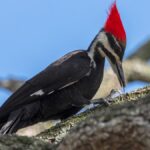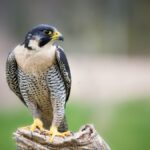In the wild symphony of nature, one sound stands out distinctively—the rhythmic drumming of woodpeckers. With relentless determination, these extraordinary birds peck away at trees, creating a spectacle that captivates our attention and piques our curiosity. But what drives these fascinating creatures to engage in such persistent pecking?
In this post, we embark on a journey to uncover the secrets behind why woodpeckers peck. We will delve into the fascinating world of these avian drummers, exploring their behaviors, adaptations, and the ecological significance of their pecking.
Discover the remarkable adaptations allowing woodpeckers to hammer away at trees without harm. From their specially designed beaks to shock-absorbing tissues and powerful neck muscles, these adaptations unlock the door to their pecking prowess.
Join us as we explore the multifaceted reasons behind woodpeckers’ pecking behavior. Learn about their foraging techniques as they unearth hidden insects and larvae beneath the bark. Explore the communication aspect of their drumming, where resonant beats convey territorial ownership and courtship messages.
Why do Woodpeckers Peck?
Woodpeckers engage in pecking behavior for several reasons: feeding, communication, and territoriality. Here are the main purposes behind their pecking:
- Feeding: Woodpeckers are mainly insectivorous, and they peck at tree trunks and branches to locate and extract insects and larvae hidden beneath the bark. Their strong, chisel-shaped beaks allow them to excavate wood and access their prey. By pecking, they create holes or cavities to reach insects, grubs, ants, beetles, and other invertebrates, which constitute their primary food source.
- Drumming and Communication: Woodpeckers also use pecking as a form of communication. They drum on tree trunks, branches, or other resonating surfaces to establish territories, attract mates, and communicate with other woodpeckers. Each species has its unique drumming pattern, and individuals recognize and interpret these drumming sounds within their population.
- Excavating Nest Cavities: Many woodpecker species construct their nests by excavating cavities in dead or living trees. Pecking is a vital part of this process. Woodpeckers create a hole large enough to enter and build a nest inside. The excavation serves as a protective shelter for their eggs and nestlings, safeguarding them from predators and harsh weather conditions.
- Marking Territories: Woodpeckers use pecking to mark and defend their territories. They establish their presence by pecking on tree trunks, producing distinct sounds that act as territorial signals. These signals communicate to other woodpeckers that the area is already claimed, helping prevent conflicts between individuals of the same species.
It’s worth noting that excessive pecking or pecking on man-made structures, such as buildings or utility poles, is considered abnormal behavior and can be attributed to various factors like habitat loss, food scarcity, or misguided territorial instincts.
Identify the Type of Woodpecker Causing Damage
Different woodpecker species have distinct physical characteristics and habits. To identify the specific type of woodpecker causing damage, it would be helpful to have more information or provide a detailed description of the bird’s appearance and behavior. Here are a few common woodpecker species and some key features that may aid in identification:
- Downy Woodpecker (Picoides pubescens): This is one of the smallest woodpecker species in North America. It has a black-and-white plumage pattern with a white underside and black wings marked with white spots. Males have a small red patch on the back of their heads.
- Hairy Woodpecker (Picoides villosus): Similar in appearance to the Downy Woodpecker, the Hairy Woodpecker is slightly larger. It also has a black-and-white plumage pattern, but the white outer tail feathers are more noticeable in flight. Like the Downy Woodpecker, males have a red patch on their heads.
- Northern Flickers (Colaptes auratus): Flickers are larger woodpeckers with a distinctive appearance. They have a brown bodies with black bars on their backs and a prominent white rump patch visible in flight. The undersides of their wings have a bright yellow or red coloration, depending on the region and subspecies.
- Pileated Woodpecker (Dryocopus pileatus): The Pileated Woodpecker is one of the largest woodpecker species in North America. It has a predominantly black body with a red crest on its head. The bird’s wings are black with white patches, and it has a long, chisel-like bill.
By providing specific details about the woodpecker’s size, plumage patterns, coloration, distinctive markings, and behavior, it would be easier to narrow down the identification to a particular species. Alternatively, you could consult a local birding guidebook or online birding resources or seek assistance from a local ornithological society or birding community in your area for more accurate identification.
How Can Woodpecker Damage Be Prevented?
Woodpecker damage can be prevented or mitigated by implementing certain measures to make the area less attractive or accessible to the birds. Here are some methods commonly used to prevent woodpecker damage:
- Visual deterrents: Installing visual deterrents can help discourage woodpeckers from targeting specific areas. Options include hanging reflective objects near the affected area, such as aluminum foil or reflective tape. Windsocks, scare balloons, or plastic owls may also deter woodpeckers by creating movement and mimicking the presence of predators.
- Auditory deterrents: Woodpeckers are sensitive to loud or unexpected noises. Using auditory deterrents such as wind chimes, bells, or even a radio set to a talk radio station can help deter woodpeckers from the area.
- Physical barriers: Installing physical barriers can prevent woodpeckers from accessing the affected area. Ensure the barriers are securely fastened to prevent the woodpeckers from finding their way underneath. Netting or wire mesh can be placed over susceptible surfaces to block the birds from reaching the wood or siding.
- Visual disguises: Covering the damaged surface with visual disguises can help deter woodpeckers. Hang netting or cloth over the area, or use burlap or other textured materials to create a visual barrier. The altered texture and appearance may make the area less attractive to the birds.
- Food source removal: If woodpeckers are attracted to the area due to the presence of insects or larvae, address the underlying food source. Treat the affected trees with insecticides or consult a pest control professional to eliminate the insects, making the area less appealing to woodpeckers.
- Nest box provision: Providing suitable nest boxes or birdhouses for woodpeckers can help redirect their pecking behavior. By offering an alternative nesting site, you may encourage woodpeckers to establish their homes in a more desirable location.
Remember, laws in many regions protect woodpeckers, so it is essential to choose non-harmful methods that do not cause injury to the birds. Checking local regulations and consulting with experts or wildlife authorities before taking action is advisable.
Suppose woodpecker damage persists or becomes a severe issue. In that case, seeking guidance from a wildlife professional or ornithologist with experience managing woodpecker-related problems in your area may be helpful.
Seek Professional Help if Necessary
Seeking professional help is advisable if you face persistent or severe issues related to woodpecker damage or require specific expertise in managing woodpecker-related problems. Professional assistance can ensure appropriate and effective measures are taken while considering local regulations and wildlife conservation guidelines.
Here are some situations where seeking professional help may be beneficial:
- Conservation authorities: If you live in an area where woodpeckers are protected by wildlife conservation laws, consulting with local conservation authorities can guide how to address woodpecker issues while ensuring compliance with legal requirements.
- Wildlife experts or ornithologists: Consulting with wildlife experts or ornithologists specializing in avian behavior and management can provide valuable insights and tailored advice for your situation. They can assess the extent of the problem, identify the woodpecker species involved, and offer recommendations for effective prevention or mitigation strategies.
- Pest control professionals: In cases where woodpecker damage is causing significant structural or economic harm, it may be appropriate to consult with pest control professionals specializing in bird management. They can provide options for humane deterrents or exclusion techniques that minimize harm to the woodpeckers and your property.
- Licensed contractors: If you need assistance installing physical barriers or making structural repairs to prevent woodpecker damage, hiring licensed contractors experienced in wildlife management or bird control can ensure that the work is done effectively and in compliance with applicable regulations.
By seeking professional help, you can tap into specialized knowledge and expertise to address woodpecker-related issues responsibly and effectively.




